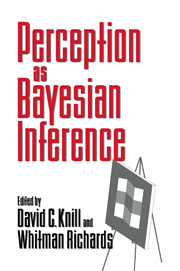Book contents
- Frontmatter
- Contents
- List of contributors
- Preface
- 0 Introduction
- Part one Bayesian frameworks
- Commentaries
- Part two Implications and applications
- 6 Implications of a Bayesian formulation of visual information for processing for psychophysics
- 7 Shape from texture: Ideal observers and human psychophysics
- 8 A computational theory for binocular stereopsis
- 9 The generic viewpoint assumption in a Bayesian framework
- 10 Experiencing and perceiving visual surfaces
- 11 The perception of shading and reflectance
- 12 Banishing the homunculus
- Commentaries
- Author index
- Subject index
7 - Shape from texture: Ideal observers and human psychophysics
Published online by Cambridge University Press: 05 March 2012
- Frontmatter
- Contents
- List of contributors
- Preface
- 0 Introduction
- Part one Bayesian frameworks
- Commentaries
- Part two Implications and applications
- 6 Implications of a Bayesian formulation of visual information for processing for psychophysics
- 7 Shape from texture: Ideal observers and human psychophysics
- 8 A computational theory for binocular stereopsis
- 9 The generic viewpoint assumption in a Bayesian framework
- 10 Experiencing and perceiving visual surfaces
- 11 The perception of shading and reflectance
- 12 Banishing the homunculus
- Commentaries
- Author index
- Subject index
Summary
Introduction
Texture cues in the image plane are a potentially rich source of surface information available to the human observer. A photograph of a cornfield, for example, can give a compelling impression of the orientation of the ground plane relative to the observer. Gibson (1950) designed the first experiments to test the ability of humans to use this texture information in their estimation of surface orientation. Since that time, various authors have proposed and tested hypotheses concerning the relative importance of different visual cues in human judgements of shape from texture (Cutting & Millard, 1984; Todd & Akerstrom, 1987). This work has generally relied on a cue conflict paradigm in which one cue is varied while the other is held constant. This is potentially problematic, since surfaces with conflicting texture cues do not occur in nature. It is possible that in a psychophysical experiment our visual system might employ a different mechanism to resolve the cue conflict condition. We show in this paper that the strength of individual texture cues can be measured and compared with an ideal observer model without resorting to a cue conflict paradigm.
Ideal observer models for estimation of shape from texture have been described by Witkin (1981), Kanatani & Chou (1989), Davis et al. (1983), Blake & Marinos (1990), Marinos & Blake (1990). Given basic assumptions about the distribution and orientation of texture elements, an estimate of surface orientation can be obtained, together with crucial information about reliability of the estimate.
Information
- Type
- Chapter
- Information
- Perception as Bayesian Inference , pp. 287 - 322Publisher: Cambridge University PressPrint publication year: 1996
Accessibility standard: Unknown
Why this information is here
This section outlines the accessibility features of this content - including support for screen readers, full keyboard navigation and high-contrast display options. This may not be relevant for you.Accessibility Information
- 3
- Cited by
